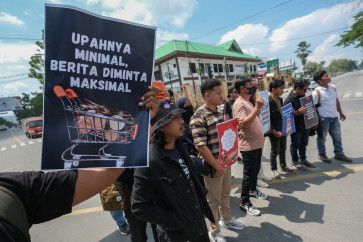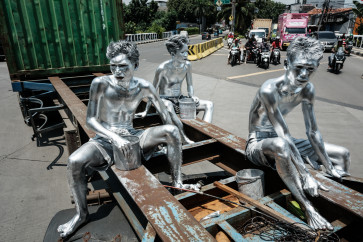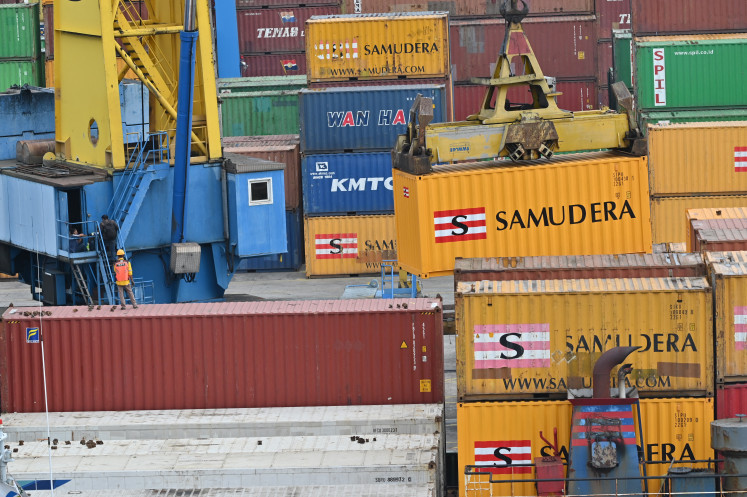Jakarta ends aid as UNHCR finds solution for asylum seekers
Time’s up: Refugees hold a protest in front of the United Nations High Commissioner for Refugees (UNHCR) office in Kebon Sirih, Central Jakarta, on July 31
Change text size
Gift Premium Articles
to Anyone

T
ime’s up: Refugees hold a protest in front of the United Nations High Commissioner for Refugees (UNHCR) office in Kebon Sirih, Central Jakarta, on July 31. They demanded that the UNHCR expedite their resettlement to a third country.(JP/Dhoni Setiawan)
Refugees asked to move out of temporary shelter
Hundreds of asylum seekers have been asked to move out of their temporary shelter in Kalideres in West Jakarta and to seek their own accommodation amid looming uncertainties about their future.
Officers from the United Nations High Commissioner for Refugees (UNHCR) started on Wednesday gradually dispersing more than 1,000 asylum seekers from various war-torn countries such as Afghanistan, Somalia and Sudan staying at the shelter.
The move was taken following a request from the Jakarta administration to vacate the former building of the West Jakarta Military Command (Kodim) where they had been staying for the past six weeks. In mid-July, the city administration allowed the asylum seekers camping on the sidewalks across from the UNHCR’s office in Kebon Sirih, Central Jakarta to move into the empty building for humanitarian reasons.
However, after weeks of granting aid to the asylum seekers, the administration decided to pull the plug. The city has asked the UNHCR to manage the refugees as the city wants the building to be vacant before Sunday.
City secretary Saefullah said the administration could no longer extend the aid to the asylum seekers as the responsibility did not lie with the administration.
“What we have given is enough. We have maximized our efforts to give aid. There are programs from the UNHCR to provide additional aid,” he said at City Hall on Thursday.
UNHCR representative to Indonesia Thomas Vargas said the agency had been working with government agencies, partners and with the refugee communities themselves to facilitate the transition out of the site.
“Through these efforts, to date, some 350 individuals have left the site,” he said in a written statement on Friday.
He explained that before leaving the site, the asylum seekers were provided with counseling and some assistance including fund allowance in various amounts to help them get back on their feet.
During their stay in the Kodim building, the Jakarta Social Affairs Agency provided them with food, water, electricity and other basic needs. However, several weeks ago, the administration decided to stop all logistical aid for the refugees and to close the shelter.
“We [the city administration] don’t have the authority to manage the asylum seekers. It falls under the domain of the UNHCR and the central government. The city administration merely helped fulfilling their basic needs temporarily for humanitarian reasons. But providing a long-term solution for the refugees is beyond our authority,” Jakarta Governor Anies Baswedan said on Thursday, stressing that a lack of funds was not the reason the city stopped the aid.
Jakarta National and Political Unity Office (Kesbangpol) acting head Taufan Bakri said the UNHCR, with the help of a corporate social responsibility (CSR) program from its company partners, had managed to distribute a small amount of money for asylum seekers who had been removed from the shelter.
“The UNHCR with the help of its company partners gave funds to around 400 asylum seekers who left the shelter so that they could find new places to live. However, the CSR program could only fund around 400 people, so the UNHCR is still searching for funds to be given to the 600 people still staying in the shelter,” Taufan told The Jakarta Post on Friday.
The relocation seems to have caused an even bigger frustration for many refugees sheltered in Kalideres, who fear an uncertain future.
Refugee from Afghanistan, Alikhan, said he had no idea when he would be removed from the shelter.
“I don’t know when I will be removed from here,” he said, adding that the remaining asylum seekers in the shelter had been struggling with limited water supply and poor sanitation.
Around 500 people remained in the shelter on Saturday, he said.
“Tomorrow [Sunday] probably the officials will come here and close the shelter and we'll be homeless, we don't know where we should go," he said.
Nazifah Wahidzeda of Afghanistan said she was tired of living on the street with her two sons, 3-year-old Muhammad Zaki and 2-year-old Muhammad Faiz, without any certainty.
“We’ve been staying in Indonesia for one-and-a-half years, living on the street, relying on help from strangers. All of our money, food, and clothing comes from donations. We are living on the street but we are not allowed to work. I’m very tired, I can’t go back to my country because it is still war-torn,” she told the Post on Thursday in fluent Indonesian while trying to hold back her tears.
The 22-year-old mother expressed her frustration about being removed from the shelter, saying the allowance given by the UNHCR would not help her family survive for very long.
“They give our family Rp 1.8 million [US$125]. Renting a room in Jakarta costs around Rp 800,000 a month, what about the electricity bill or the cost of food for my sons? How long could we survive with that amount of money?” she said.
Vargas said the UNHCR understood the refugees’ frustration and it was working on a long-term solution for them by providing opportunities for livelihoods and self-reliance.
Refugees and asylum seekers currently have no legal basis to work In Indonesia. As a nonparty to the 1951 Refugee Convention and its protocol, Indonesia is not legally obligated to take in refugees including giving them the right to work. (nal)









